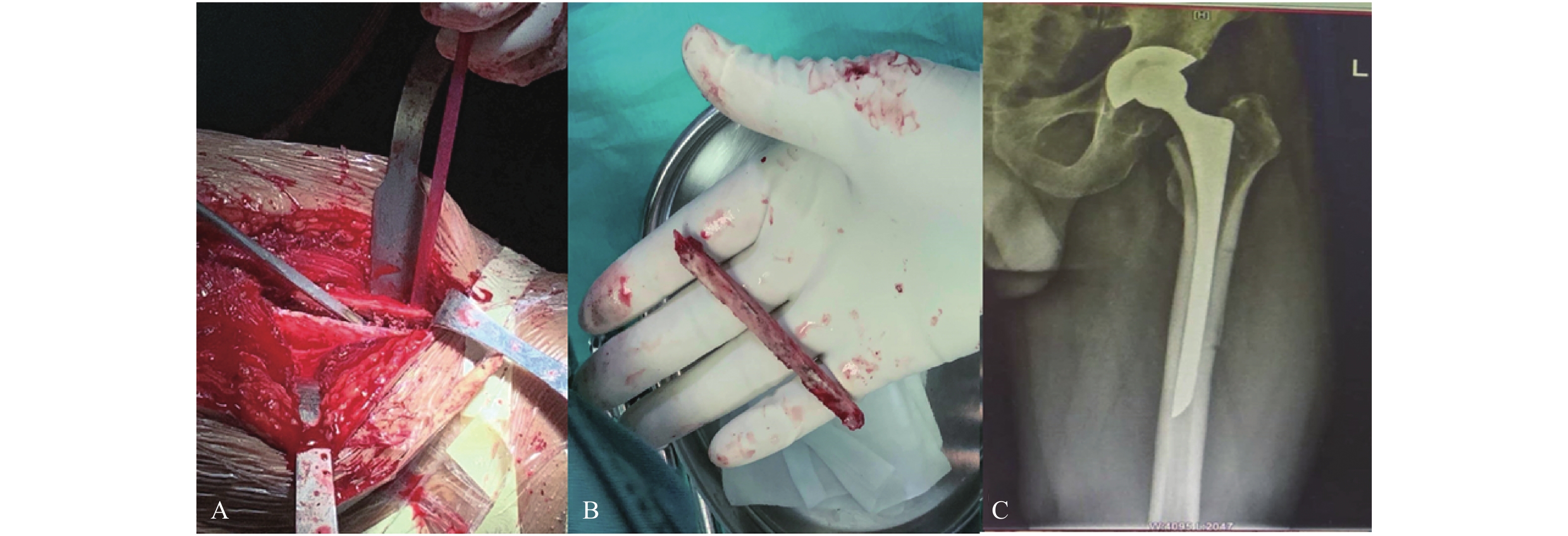Comparative Study of Windowing the Femur Diaphysis and Extended Trochanteric Osteotomy in Femoral Revision Surgery
-
摘要:
目的 股骨前外侧皮质开窗技术与大转子延长截骨术(ETO)在取出困难的股骨侧假体翻修术中的比较。 方法 回顾性分析2014年1月至2019年3月在昆明医科大学第一附属医院用股骨开窗技术行股骨侧翻修术患者18例(18髋)。选择同期在使用大转子延长截骨术行翻修患者12例(12髋)作为对照组。记录手术时间及失血量,使用Harris评分、外展肌MRC评分等标准评估髋关节功能,用影像学随访观察假体位置及截骨块愈合情况,评估并记录有无钢丝钢缆相关的并发症。 结果 (1)手术时间及出血量开窗组与ETO组比较,差异无统计学意义(P > 0.05);(2)术后开窗组Harris评分及外展肌力MRC评分均高于ETO组比较,差异有统计学意义( P < 0.05);(3)随访期间开窗组有2例下沉,但不影响假体稳定性,随访6月后未见进一步下沉;ETO组未见假体下沉及截骨块移位。随访1 a时,所有患者均可负重行走,X线片示两组患者截骨块均愈合;(4)短期回访未见钢丝钢缆相关的并发症。 结论 股骨开窗技术与ETO相比,不涉及股骨近端及附着的肌肉,患者可早期主动活动髋关节,且可使用普通生物柄翻修,短期随访示髋关节功能优于ETO组;股骨开窗截骨块较小,可不使用钢缆或钛捆绑带固定而避免环扎固定相关的并发症。 Abstract:Objective To compare windowing the femur diaphysis and extended trochanteric osteotomy for hip implants extraction in revision surgery. Methods We retrospective analyzed data of 18 patients (18 hips) with primary hip arthroplasty undergone windowing the femur diaphysis for implants removal from January 2014 to March 2019. Twelve patients (12 hips) treated with ETO for implants removal associated with femur revision surgery at the same stage were chosen as control group. Operation time and blood loss were recorded, and Harris score and Abductor MRC score were used to evaluate the hip function. Radiographic follow-up was performed to observe the position of the prosthesis and the healing of the osteotomy, and to evaluate and record the presence of complications related to steel wires. Results There was no statistically difference in operation time and blood loss between the two groups (P > 0.05). The Harris score and abductor muscle strength (MRC) score in the windowing group were higher than those in the ETO group, and the differences were statistically significant ( P < 0.05). During the follow-up, there were 2 cases of subsidence in the window-opening group, which did not affect the stability of the prosthesis, and no further subsidence was observed after 6 months of follow-up; while no prosthesis subsidence and osteotomy displacement were observed in ETO group. After 1 year of follow-up, all patients were able to walk with weight, and the X-ray films showed that the osteotomy was healed in both groups. No complications related to fixation using a cable or wire cable was seen during short-term follow-up. Conclusion Compared with ETO, the proximal of the femur with the muscle insertions remain intact in windowing technique, so patient can start exercise earlier after operation. And cementless stem can be used for revision surgery. During short-term follow-up, the hip functions in windowing group are better than those in ETO group. The osteotomized fragment in window technique is smaller than ETO, so it can be fixed without cable wire or titanium band and related complications avoided. -
Key words:
- Revision total hip arthroplasty /
- Revision femur /
- Hip prosthesis /
- Windowing /
- Arthroplasty
-
表 1 与ETO组患者术后临床评分比较(
$\bar x \pm s$ )Table 1. Comparison of postoperative clinical evaluations with ETO group (
$\bar x \pm s$ )组别 n Harris评分(分) 外展肌力评分(分) 6个月 1 a 6个月 1 a 开窗组 18 88.5 ± 2.95 89.7 ± 1.51 4.6 ± 0.50 4.8 ± 0.38 ETO组 12 85.2 ± 1.22 88.8 ± 1.47 NA 4.0 ± 0.00 t/P t = 3.351 t = 1.650 NA t = 6.814 P = 0.002* P = 0.111* NA P < 0.001 NA:不可用;*P < 0.05。 -
[1] 冯硕,查国春,郭开今,等. 髋关节股骨侧翻修:原因,分型及不同修复技术的应用原则[J]. 中国组织工程研究,2018,22(15):2396. doi: 10.3969/j.issn.2095-4344.0760 [2] Younger T I,Bradford M S,Magnus R E,et al. Extended proximal femoral osteotomy:A new technique for femoral revision arthroplasty[J]. The Journal of Arthroplasty,1995,10(3):329-338. doi: 10.1016/S0883-5403(05)80182-2 [3] 马庆,尚希福. 股骨大粗隆延长截骨术的临床应用进展[J]. 中国骨与关节损伤杂志,2019,34(06):669-671. [4] 康鹏德,裴福兴,沈彬,等. 股骨大转子延长截骨在假体稳定股骨柄翻修中的应用[J]. 中华外科杂志,2009,47(3):177-180. doi: 10.3760/cma.j.issn.0529-5815.2009.03.005 [5] 杨轶伦,陶树清. 股骨近端开窗手术的研究[J]. 河北医学,2017,23(12):2101-2104. doi: 10.3969/j.issn.1006-6233.2017.12.051 [6] Wilson L J,RichardsI C J,Irvined D,et al. Risk of periprosthetic femur fracture after anterior cortical bone windowing[J]. Acta Orthopaedica,2011,82(6):674-678. doi: 10.3109/17453674.2011.636670 [7] 高明,李锋,陶树青. 股骨近端不同位置开窗对股骨强度的影响[J]. 中国现代医学杂志,2018,28(9):85-87. doi: 10.3969/j.issn.1005-8982.2018.09.016 [8] Nilsdotter A,Bremander A. Measures of hip function and symptoms: Harris hip score (HHS),hip disability and osteoarthritis outcome score (HOOS),oxford hip score (OHS),lequesne index of severity for steoarthritis of the hip (LISOH),and american academy of orthopedic surgeons (AAOS) hip and knee questionnaire[J]. Arthritis Care & Research,2011,63(S11):200-207. [9] Paternostro Sluga T,Grim Stieger M,Posch M,et al. Reliability and validity of the medical research council (MRC) scale and a modified scale for testing muscle strength in patients with radial palsy[J]. Journal of Rehabilitation Medicine,2008,40(8):665. [10] Meek R M D,Garbudz D S,Masri B A,et al. Intraoperative fracture of the femur in revision total hip arthroplasty with a diaphyseal fitting stem[J]. JBJS,2004,86(3):480. doi: 10.2106/00004623-200403000-00004 [11] Charity J,Tsiridis E,Gusmoão D,et al. Extended trochanteric osteotomy followed by cemented impaction allografting in revision hip arthroplasty[J]. The Journal of Arthroplasty,2013,28(1):154-160. doi: 10.1016/j.arth.2012.07.002 [12] Wieser K,Zingg P,Dora C. Trochanteric osteotomy in primary and revision total hip arthroplasty:Risk factors for non-union[J]. Archives of Orthopaedic and Trauma Surgery,2012,132(5):711-717. doi: 10.1007/s00402-011-1457-4 [13] Sambandam S N,Duraisamy G,Chandrasekharan J,et al. Extended trochanteric osteotomy:Current concepts review[J]. European Journal of Orthopaedic Surgery & Traumatology,2016,26(3):231-245. [14] Park C H,Yeom J,Park J W,et al. Anterior cortical window technique instead of extended trochanteric osteotomy in revision total hip arthroplasty:A minimum 10-year follow-up[J]. Clinics in Orthopedic Surgery,2019,11(4):396-402. doi: 10.4055/cios.2019.11.4.396 [15] Huffman G R,Ries M D. Combined vertical and horizontal cable fixation of an extended trochanteric osteotomy site[J]. Journal of Bone & Joint Surgery-american Volume,2003,85(2):273-277. [16] Schwab J H,Camacho J,Kaufman K,et al. Optimal fixation for the extended trochanteric osteotomy:A pilot study comparing 3 cables vs 2 cables[J]. The Journal of Arthroplasty,2008,23(4):534-538. doi: 10.1016/j.arth.2007.05.028 [17] Zhu Z,Ding H,Shao H. An in-vitro biomechanical study of different fixation techniques for the extended trochanteric osteotomy in revision THA[J]. Journal of Orthopaedic Surgery & Research,2013,8(1):7. [18] Brown J M,Mistry J B,Cherian J J,et al. Femoral component revision of total hip arthroplasty[J]. Orthopedics,2016,39(6):e1129-e1139. doi: 10.3928/01477447-20160819-06 [19] Waligora A C T,Owen J R,Wayne J S,et al. The effect of prophylactic cerclage wires in primary total Hip arthroplasty:A riomechanical study[J]. J Arthroplasty,2017,32(6):2023-2027. doi: 10.1016/j.arth.2017.01.019 [20] Lenz M,Perren S M,Richards R G,et al. Biomechanical performance of different cable and wire cerclage configurations[J]. Int Orthop,2013,37(1):125-130. doi: 10.1007/s00264-012-1702-7 [21] 程琪,赵凤朝,郭开今,等. 钢缆环扎固定治疗初次人工髋关节置换术中股骨假体周围骨折的中期疗效[J]. 中国修复重建外科杂志,2017,31(11):1291-1294. [22] Beck M,Krügera A,Katthagen C,et al. Osteotomy of the greater trochanter:Effect on gluteus medius function[J]. Surgical and Radiologic Anatomy,2015,37(6):599-607. doi: 10.1007/s00276-015-1466-z [23] Springer B D,Berry D J,Lewllen D G. Treatment of periprosthetic femoral fractures following total hip arthroplasty with femoral component revision[J]. Journal of Bone & Joint Surgery American Volume,2003,85-A(11):2156. [24] Levine B R,Valle C J D,Lewis P,et al. Extended trochanteric osteotomy for the treatment of vancouver B2/B3 periprosthetic fractures of the femur[J]. Journal of Arthroplasty,2008,23(4):527-533. doi: 10.1016/j.arth.2007.05.046 -






 下载:
下载:





